There’s something about Bali.

If you’ve never been to Bali, then the first thing you’ll probably think of are its sandy beaches. As idyllic as many of them are, they tell just a part of Bali’s story. Within days of our first trip, we learned that there’s so much more to this popular island destination than just sand and surf.
For beginers, it’s home to a thriving food and arts scene that’s more developed than anything we’ve seen in Southeast Asia. Instagram-worthy villas with infinity pools are the norm and there’s a wealth of cultural attractions to be experienced like Hindu water temples and Balinese dance shows.
But maybe the one thing that struck me the most was the vibe. There’s an energy to this place that’s hard to put into words. When you’re there, you just feel it.
Travelwithease team went to Bali expecting it to be like any other island destination in Southeast Asia. We expected to like it, but perhaps not enough to really want to go back. We were wrong.
TRAVEL RESTRICTIONS
Because of the current global situation, travel guidelines have been changing often. Our friends at SafetyWing created a website that lists detailed information on travel restrictions around the globe.
Very important when planning a trip to Bali, be sure to check the Flatten the Curve website for information on travel restrictions to Indonesia.
BALI AT A GLANCE
Bali is an Indonesian island province located between Java and Lombok. It’s the country’s only predominantly Hindu province with an estimated 83.5% of the local population identifying themselves as Balinese Hindus. This is interesting considering how Indonesia has the largest Muslim population in the world.
Bali is characterized by its striking coastal areas and verdant interior. Hindu temples abound throughout the island, as do expressions of its highly developed arts in the fields of painting, sculpture, woodcarving, metalwork, and dance. While the south is known for its beaches, the inland town of Ubud is regarded as the cultural heart of the island and a great place to experience Balinese culture and the arts. It is one of if not Indonesia’s top tourist destination, receiving over 6.5 million international visitors in 2018 alone. Tourism-related businesses make up 80% of the island’s economy, with most of the action happening in the south.
This island is to big to cover in one article so this travel guide will focus only on southern Bali, which is where many tourists will be spending most of their time.

BEST TIME TO VISIT
Like the rest of Indonesia, Bali has two seasons – dry and rainy. The dry season is typically from April till October while the rainy season begins around November and goes on till March. Temperatures stay fairly constant throughout the year so the best time to visit Bali is during the dry season.
The best months weather-wise are usually July and August, but these are also peak months. For that reason, I think the best time to go would be from April till June and September to November. The skies are clearer and the island isn’t as crowded.
APR-OCT: This is the dry season in Bali. We were there in July on our last trip and the weather was perfect. The sky was clear everyday and it didn’t rain once. Nevertheless, it was crowded everywhere and traffic was horrible, especially in Seminyak.
NOV-MAR: This is the rainy season. November should still be ok but December and January are the rainiest months, not to mention among the busiest. Bali gets pretty crowded over the holidays so this probably isn’t the best time to go. Hotel rates will be at their highest as well.
Climate: Annual Monthly Weather in Bali
To help you better understand the climate in Bali, We’ve created the average temperature and annual rainfall graphs below. Ideal months to visit are indicated in orange.
Average Temperature

Annual Rainfall

TRAVELING TO BALI
Most visitors to Bali will probably be flying in to Ngurah Rai International Airport, which is just south of Denpasar in southern Bali. If you’re staying in the south, then it’s probably best to take a private transfer or taxi directly to your hotel. As of this writing, there’s no developed public transportation system in Bali so any other option may be more trouble that it’s worth.
BY TAXI: You can also take a taxi to your hotel but based on what I’ve read, it may be more expensive than a private transfer. You can book it at the official taxi counter inside the airport terminal. Just tell them the name of your hotel and they’ll quote you a fixed price.
BY PRIVATE TRANSFER: This is the best and most convenient option. The driver will be waiting for you at the arrival area then take you directly to your hotel.
WHERE TO EXCHANGE CURRENCY
The unit of currency in Indonesia is the Indonesian Rupiah (IDR). Southern Bali is a big area so finding the best place to change your money will depend on where you’re staying.
We didn’t need to exchange currency in Bali but based on what I’ve read, there’s a mix of reputable and shady currency exchange offices in popular tourist areas. Banks are the most reputable so if you can, then exchange your currency at an established bank.
If you don’t have access to a bank, then you can change your money at a currency exchange office. According to this article, you should only change currency at Bank Indonesia-authorized money changers.
If you don’t like brining large sums of cash on trips, then another alternative would be to withdraw IDR from an ATM. I’ve been doing this more and more now and the rates are comparable. Just be sure to let your bank know you’ll be using your ATM card abroad so you don’t run into any problems. In my experience, my card works in some ATM machines but not in others.
NOTE: When an ATM machine asks if you’d like to proceed with or without conversion, always select WITHOUT conversion. I made the mistake of proceeding WITH conversion once and wound up with a terrible exchange rate. Proceeding WITH conversion authorizes the foreign bank operating the ATM to do the conversion for you, usually at highly unfavorable rates.
WHERE TO STAY IN BALI
We’ve created the color-coded map below to help you visualize where each of these areas are. Please be advised that we’ve only stayed in Seminyak thus far, so I can only provide a first-hand account of that area. Everything else is just a brief summary based on my research.
There are so many great places to stay in Bali, ranging from 5-star luxury accommodations to humble but charming boutique hotels. The competition between hotels is so stiff that you can easily find beautiful hotels at very reasonable rates.
RED – Seminyak
TURQUOISE – Legian Beach
ORANGE – Kuta Beach
PURPLE – Jimbaran Bay
GREEN – Nusa Dua
DARK BLUE – Tanjung Benoa
PINK – Sanur Beach
YELLOW – Denpasar
BROWN – Canggu
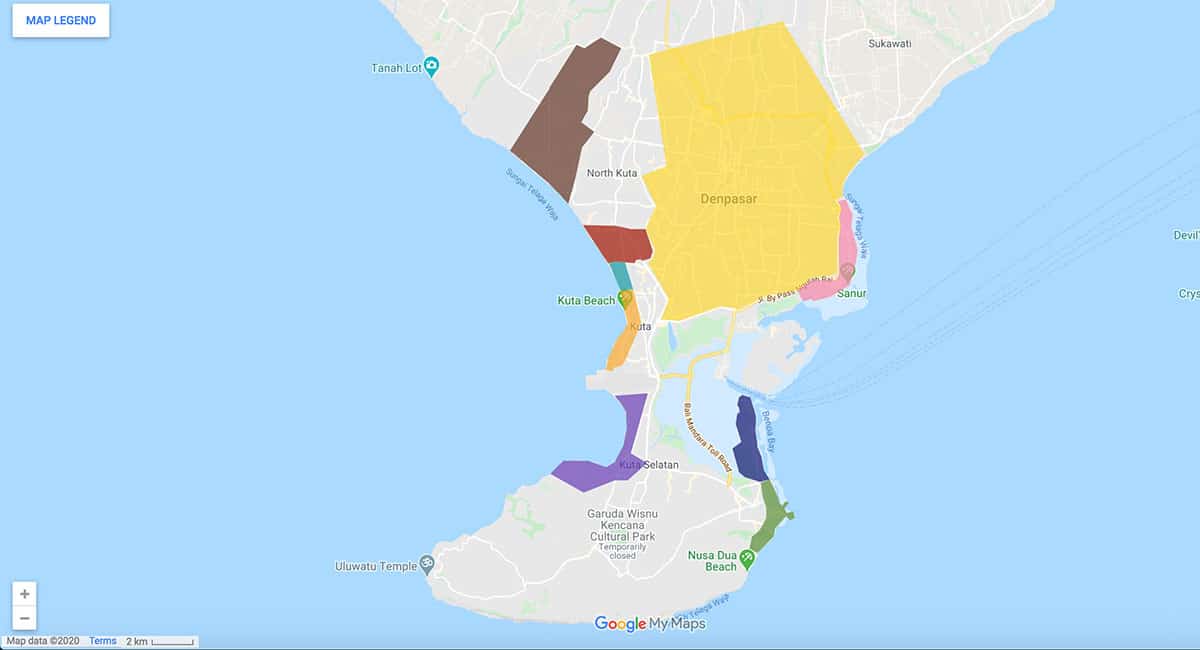
SEMINYAK: Casa Kayu Aya
This was where we stayed. Seminyak is one of the most popular areas on the island with plenty of hotels, restaurants, boutiques, and bars. It’s listed as an upscale area but there are plenty of mid-range hotels too.
As you’d expect with such a popular area, Seminyak can get crowded. Traffic can get pretty bad here as well, especially during peak seasons. Seminyak is where you’ll find some of the island’s best restaurants which is why we chose to stay here.
Casa Kayu Aya is a lovely boutique hotel just off the main road and a short walk to the beach. It’s got a pool and a nice roofdeck where they serve breakfast. We enjoyed our stay at Casa Kayu Aya and would happily book there again.
Approximate Room Rate: USD 33 per night (as of July 2019)
KUTA BEACH
Kuta Beach is the most famous beach in Bali and one of its liveliest nightlife areas. It’s also got great surfing and plenty of budget accommodations. It’s proximity to the airport makes it one of the most convenient places to stay as well.
LEGIAN BEACH
This is the area directly south of Seminyak and north of Kuta Beach, which is fitting because it’s described as being a mix between the two. Average hotel prices fall somewhere between Seminyak and Kuta Beach, and the nightlife is fun, but not as rowdy.
JIMBARAN BAY
This is the area to the south of the airport. It’s described as a quieter area with many international chain hotels and 5-star resorts. If you’re in Bali on your honeymoon, then this is probably a good place to be.
NUSA DUA
Located on the eastern side of southern Bali, Nusa Dua is described as being the most exclusive beachfront area on the island and home to some of its best white sand beaches. Almost all of the hotels here are international 5-star resorts. It sounds like another great place to stay if you’re traveling to Bali on your honeymoon.
TANJUNG BENOA
If you’re into action-packed activities like jet skiing or parasailing, then you should probably stay here. Tanjung Benoa is located directly north of Nusa Dua and is described as being one of the best places on the island for watersports.
SANUR BEACH
Sanur Beach is apparently Bali’s very first tourism beach area. It’s quieter and more laid back compared to other areas like Kuta and Legian. Honeymooners may want to consider staying here as well.
DENPASAR
Denpasar is the capital city of Bali and the most urban area on this list. If you’d prefer to stay in a city rather than a touristy beach area, then Denpasar is one to consider.
CANGGU
I first learned about this area from a fellow travel blogger. Apparently, it’s many a digital nomad’s preferred place to live when staying for many months in Bali. From what I understand, it’s a secluded area with a good balance of coastal and rice terraced environments.
THINGS TO DO
There are plenty of fun and interesting things to do in southern Bali. However, attractions are spread out and the island doesn’t have a developed public transportation system. It’s easiest to book a private car charter with driver, which is what I did, or go on a guided tour. I’ll get into the different options in more detail below.
If you’d like to visit these attractions in the cheapest way possible, then it may be best to get around using the Kura Kura shuttle bus. It’s a fleet of air-conditioned minibuses that ply set routes on the island. You can get 1-day or 3-day passes on Klook. Follow the link for more information and a list of routes and stops.
1. Explore Bali’s Shopping Streets
We stayed near the main commercial area in Seminyak and had fun exploring Jalan Kayu Aya and Jalan Raya Seminyak. Unlike less developed island destinations in Southeast Asia, Bali isn’t just about market-like stalls selling folksy crafts and souvenirs. There are many international fashion boutiques here, along with art galleries and plenty of interesting cafes, restaurants, and bars. Check out this article on Bali’s shopping streets for a quick overview.
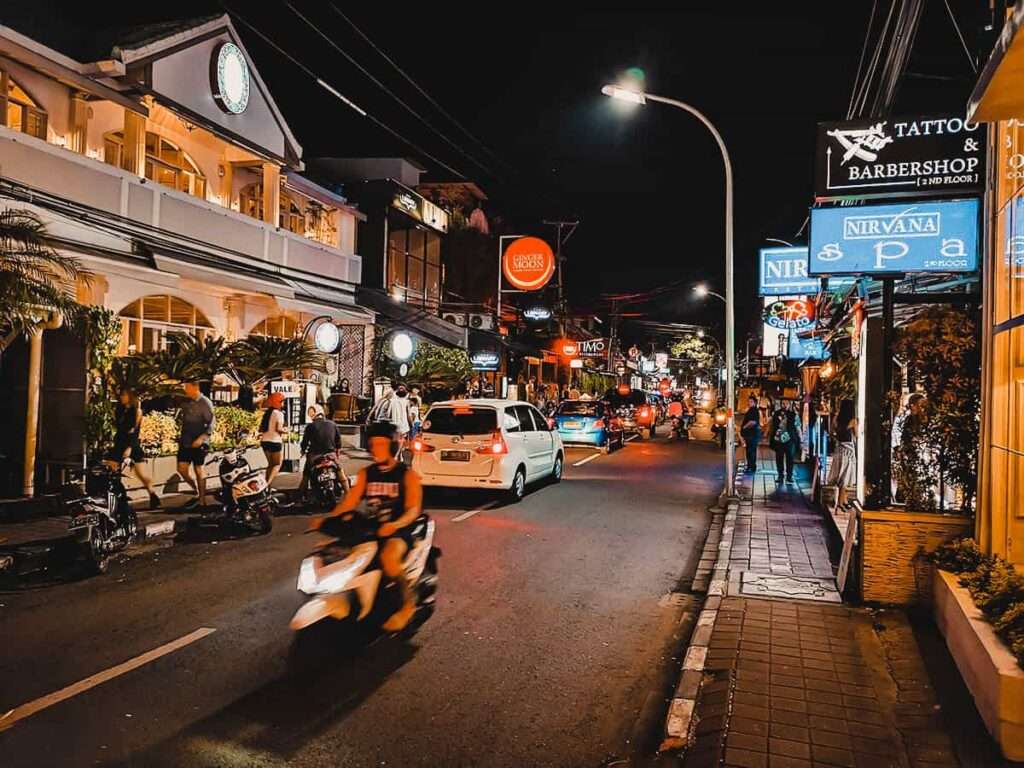
2. Enjoy the View at Tanah Lot Temple
This was the first stop I made on my private car charter. Tanah Lot is one of Bali’s most important Hindu temples. Built on a rock just off the shore, it’s also one of it’s most unique and visually striking, which is why I wanted to get here early before the crowds came in. Tanah Lot is a frequent stop on many sightseeing tours.
It was still high-tide when I visited so this was as close as I could get. At low tide, you can cross to the base of Tanah Lot though entrance to the temple itself is prohibited. After centuries of crashing waves, the temple’s rock base had eroded to the point that it needed restoration. About a third of the present rock is now artificial.
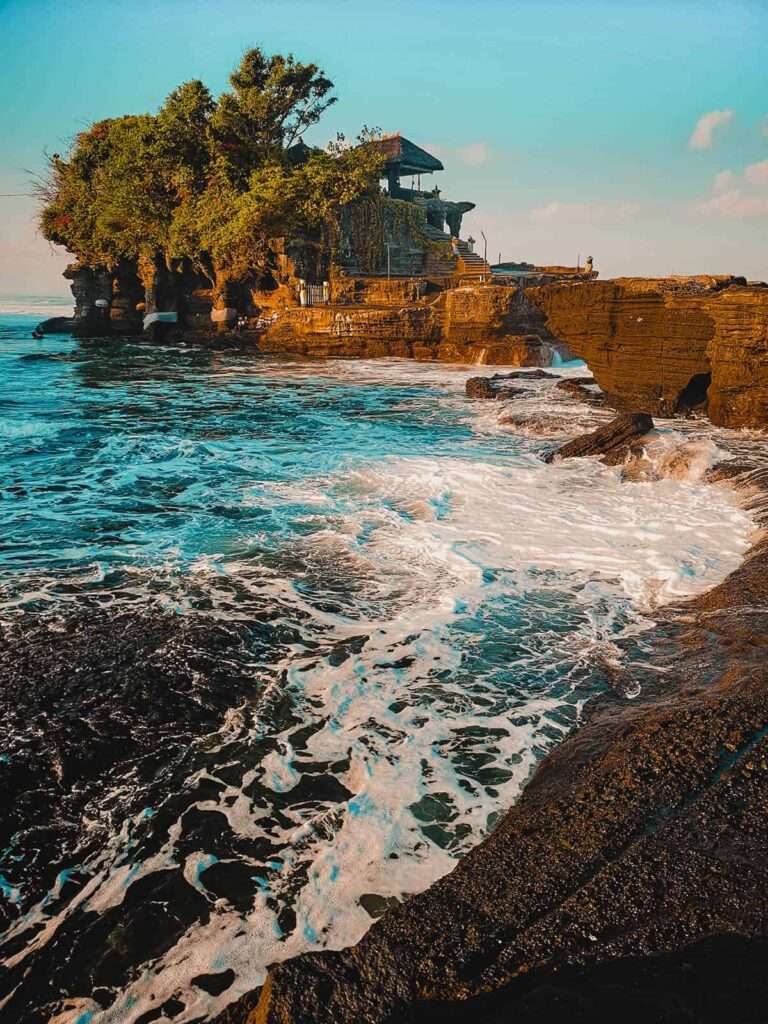
Farther along the coast is Batu Bolong Temple which you can easily get to on foot from Tanah Lot.
This entire area is lovely at this time of day. The temperature is relatively cool with few people around so you can sit and enjoy the sound of waves crashing onto shore.
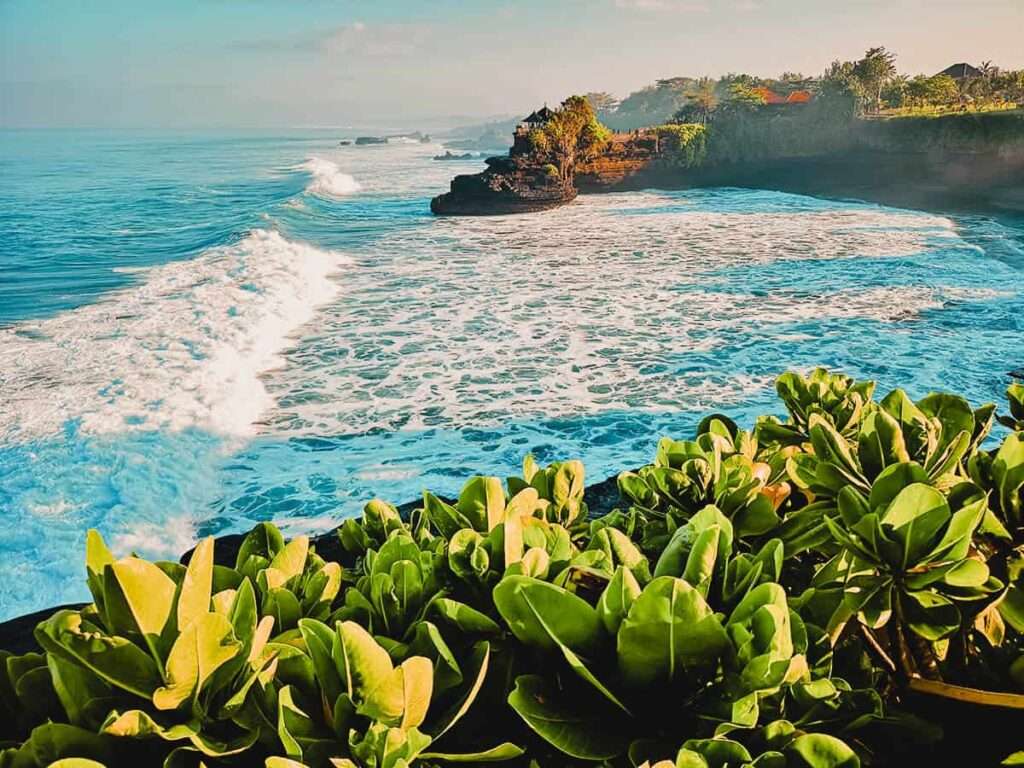
3. Explore Uluwatu Temple
Uluwatu Temple reminded me of Tanah Lot with its similarly striking ocean view backdrop. But unlike Tanah Lot which is situated on a rock off the shore, Uluwatu is perched on a sheer cliff about 70 meters above sea level. It’s a beautiful sight that’s perhaps best enjoyed at sunset. I was here midday when it was scorching hot and the light too harsh so I didn’t enjoy it as much.
Another reason to visit Uluwatu at sunset is to be able to see the spectacular Kecak fire dance which is performed everyday at 6PM. Some people say it’s touristy, but fun and entertaining nonetheless.
Warning, stay aware of the plenty of monkeys patrolling the cliffs of Uluwatu. When I was there, a large monkey had a pair of aviator sunglasses in his hands. They’ve been known to snatch items from tourists so be careful with any loose belongings like mobile phones, cameras, and dangling jewelry.
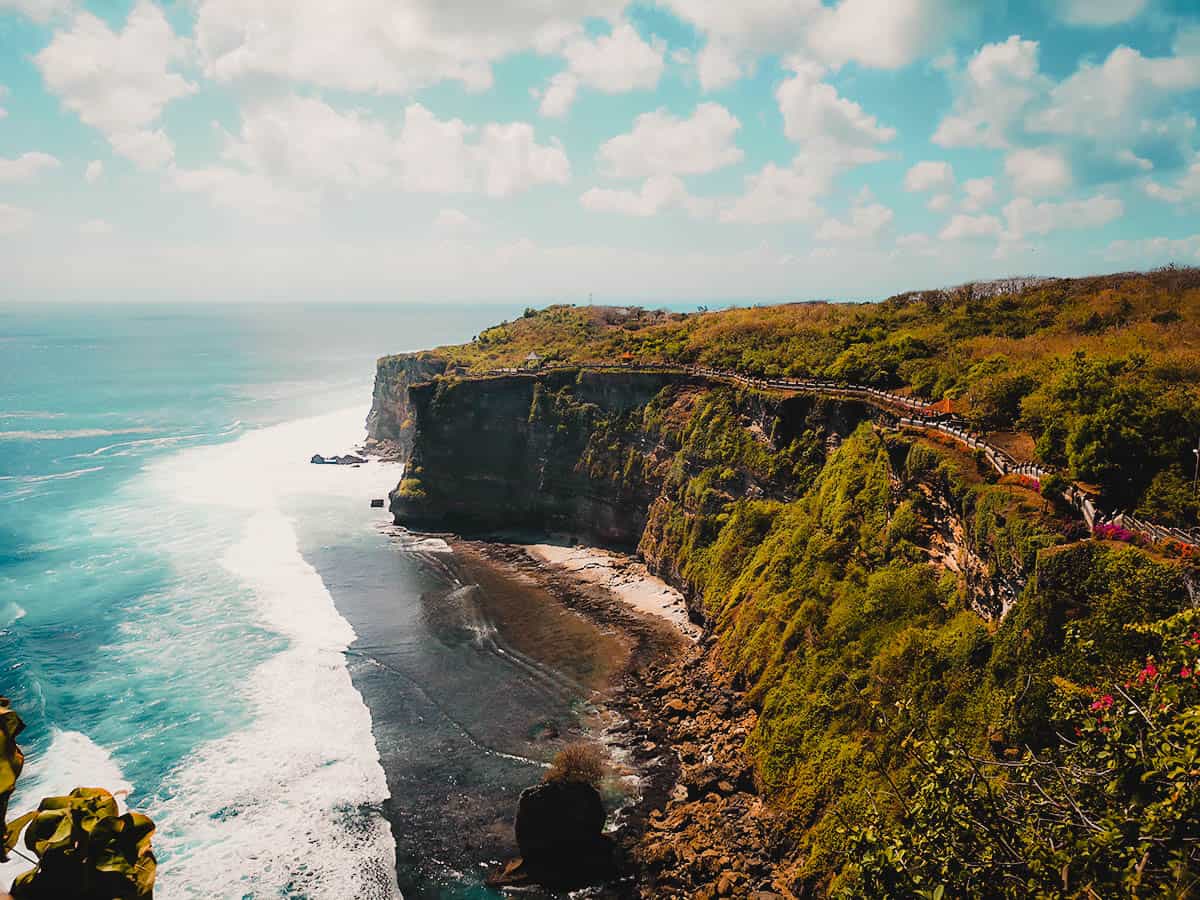
Suggested Length of Visit: 1-2 hours / Admission: IDR 30,000
4. Marvel at the Giant Statues of Garuda Wisnu Kencana Cultural Park
I wasn’t sure what to make of this place. It’s feels like a theme park but instead of rides, it features large statues. Very, very large statues. Somehow this place reminded our team a little bit to Jurassic Parks Movies.
Pictured below is the first of three gargantuan statues you’ll find at Garuda Wisnu Kencana Cultural Park (GWK for short). I didn’t notice it at first but this is actually a duplicate of one portion of the main statue. You’ll see what I mean in succeeding pictures. It depicts Vishnu – one of the principal deities in the Hindu religion – who’s known as the god of preservation and guardian of all beings.
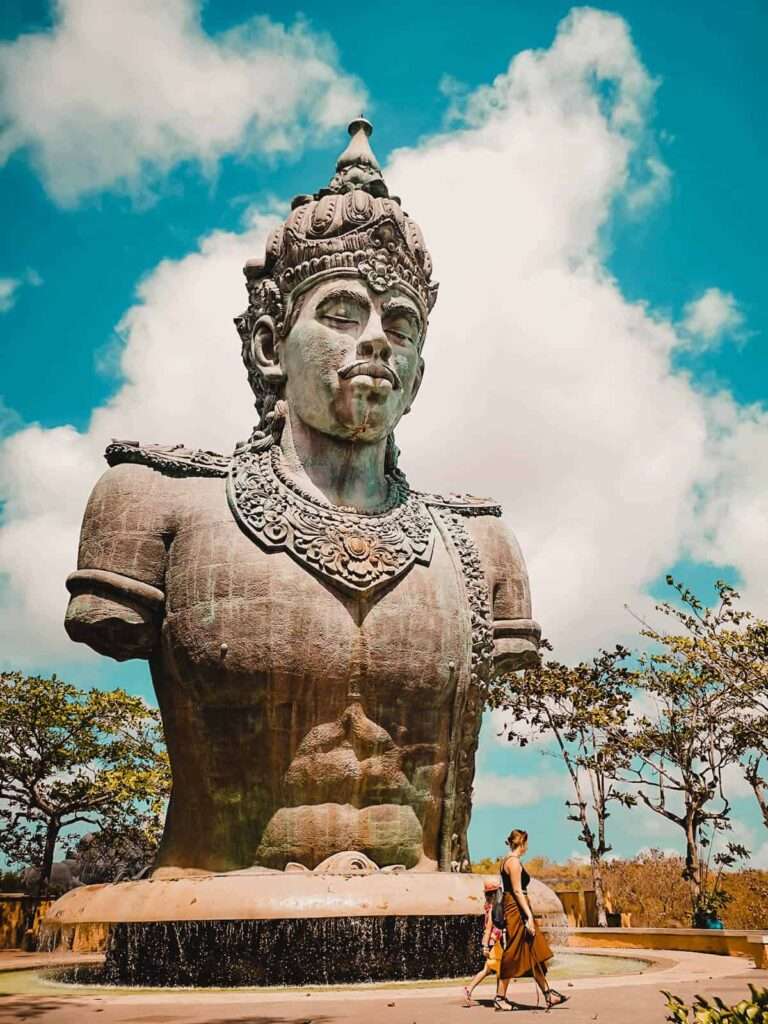
Like the statue above, this is also just one segment of the larger statue. It depicts Garuda – a legendary bird or bird-like creature in the Hindu religion. He is the trusted mount of Vishnu and recognized as a symbol of faithfulness and devotion. Check out the person in yellow walking on the lawn for scale.
The Garuda statue is looking to its left, at the park’s main attraction – a 121-meter (397 ft) tall behemoth that now stands as the tallest statue in Indonesia and the fourth tallest in the world.
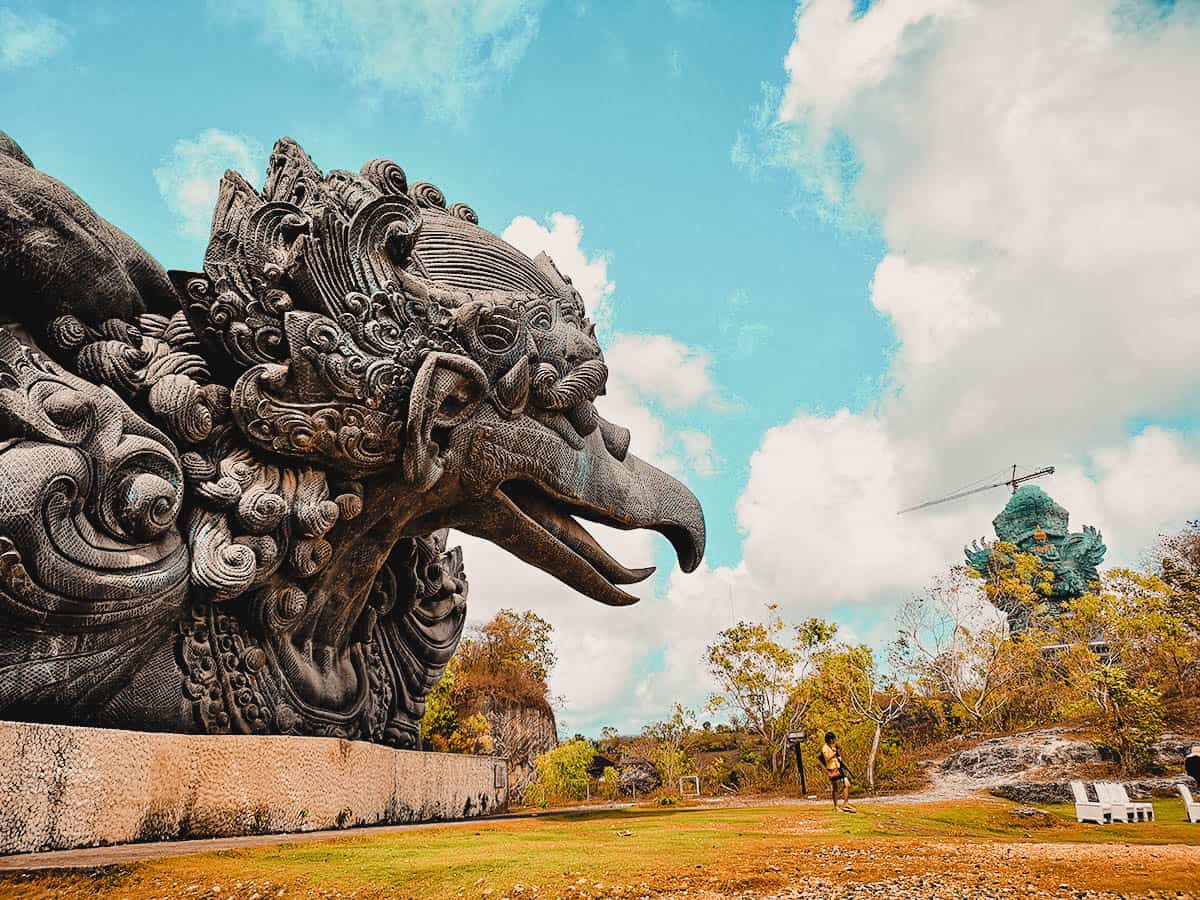
This gargantuan statue wasn’t completely finished at the time of my visit but it is now. It depicts Vishnu riding on the back of his faithful mount Garuda. Not counting its base, the statue measures 75 meters tall and consists of 754 individual pieces weighing over 3,000 tons.
Interestingly, it took 28 years for this statue to be completed. Construction began in 1997 but financial problems and other setbacks delayed its completion till September 2018 at a cost of around 100 million US dollars.
The statues are well sculpted and magnificent to see, but there isn’t much else to do at the park. It felt a bit odd to be honest as it wasn’t clear to me what this place is for. It seems to be some type of cultural events venue.
Suggested Length of Visit: 2-3 hours / Admission: IDR 125,000 (adults), IDR 100,000 (children ages 3-10)
5. Watch the Devdan Show at Nusa Dua Theater
At first, I thought this Devdan show was a cultural performance similar to the Kecak fire dance, but it looks to be more like a theatrical show in the spirit of a Cirque du Soleil or Broadway musical. It’s a visual display telling the story of two children who stumbled upon an enchanted treasure chest filled with cultural objects from different regions in Indonesia. Based on its stellar TripAdvisor reviews, it’s an entertaining show that’s fun for the entire family.
You can purchase tickets from the Nusa Dua Theater website.
Length of Show: Approximately 1.5 hours / Ticket Price: IDR 520,000-1,560,000
6. Take a Cooking Class
We took this fun cooking class in Ubud where we learned how to make Indonesian classics like gado-gado, sate, and pepes ikan. For me, there’s no better way to learn about an unfamiliar cuisine than to take a cooking class. It’s like looking under the cuisine’s hood. Other than Bali, we’ve taken cooking classes in Hoi An, Chiang Mai, and Phuket.
If you’re interested in taking a cooking class in Bali, then I suggest searching through Cookly. They’re a dedicated cooking class booking platform that offers many classes in different areas around the island like Seminyak, Kuta, and Canggu. Follow the link for a list of cooking classes in Bali.

7. Enjoy Contemporary Art
As described, Bali has a well-developed art scene. You’ll find contemporary art galleries and museums throughout the island, including the pioneering Nyaman Gallery in Seminyak. This is one of the best contemporary art galleries in Bali, showcasing an interesting mix of work from both local and international artists.
Its highly developed art scene was probably the one thing that surprised me most about Bali. I’m used to seeing just folk art in Southeast Asian island destinations, but not here. The body of contemporary art on display here is impressive. Check out this article for a list of interesting art galleries in Bali.
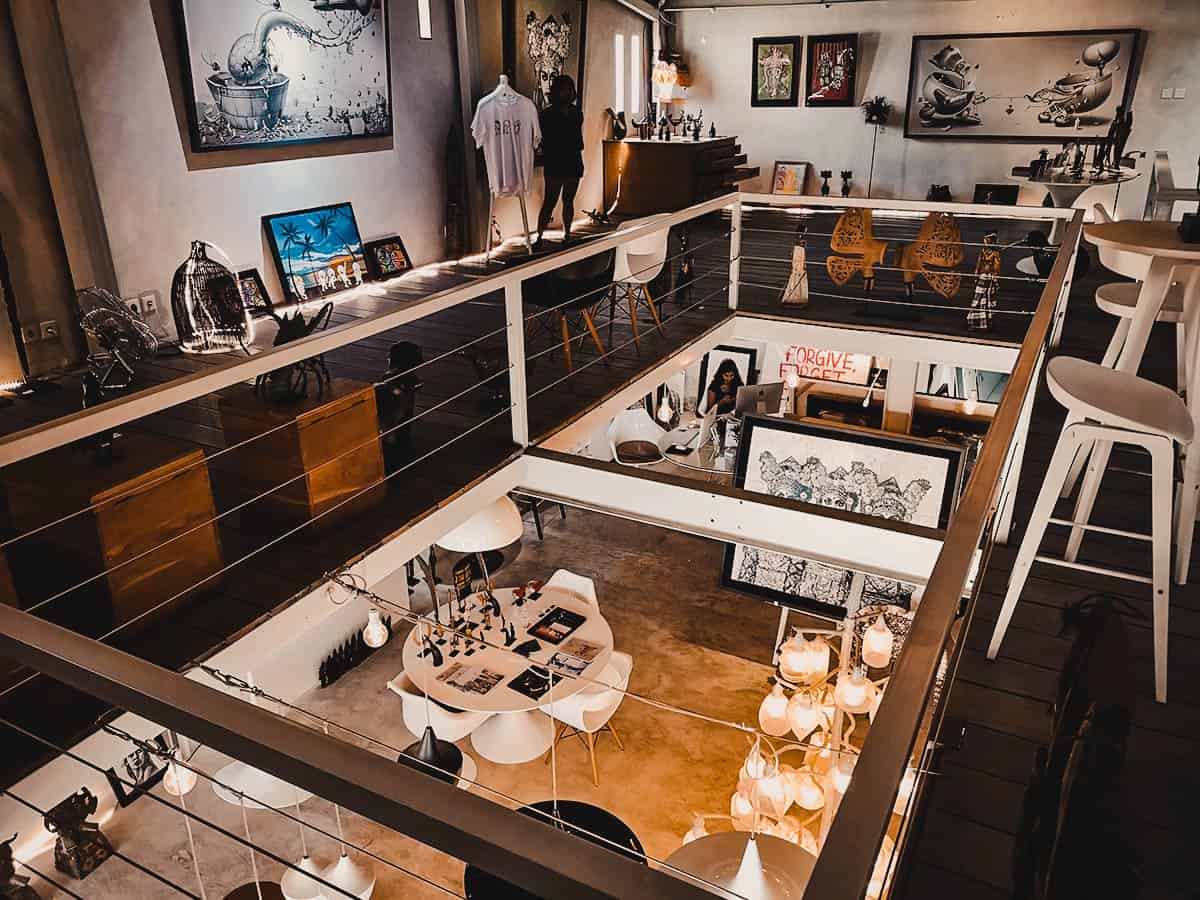
Even the commercial mass-produced art was impressive. This was a stack of paintings being sold by some sidewalk vendor in Seminyak.
8. Lay on a Beach
Doing nothing is probably one of the best things you can do in an idyllic island destination like Bali. And by “doing nothing”, I mean laying on a beach half naked just catching rays and sipping cocktails. Cliched I know, but who cares? You’re in Bali.
Being such a large island, there are plenty of beaches to choose from. We aren’t beach people so we didn’t spend too much time on the beach. Which beach(es) you go to will probably depend on where you’re staying, but you can check out this article for a list of the best beaches in Bali.
Here’s an aerial shot I took of Seminyak Beach with my drone. For many travelers, laying on sandy stretches of beach like this one is the only thing they need to do in Bali. I can’t say I blame them!
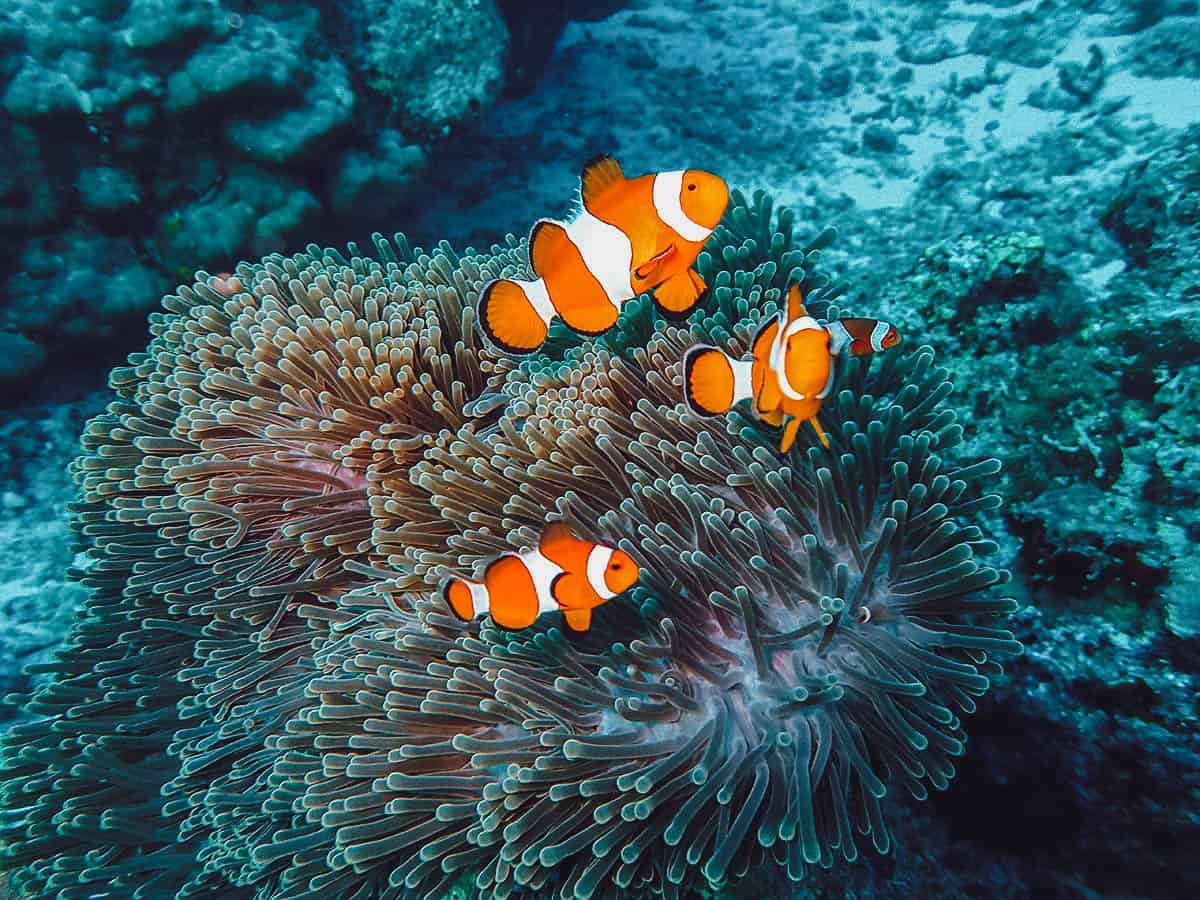
9. Make an Impact with Backstreet Academy
To be honest, I had never heard of impact travel until Backstreet Academy invited us to become ambassadors.
Impact travel is a movement that aims to provide tourists with authentic experiences while giving local communities a chance to supplement their income. Tourists can learn things like wood carving from a practicing craftsman or fishing from real fishermen during the off season, with up to 80% of tour revenues going back into the communities. Pretty cool right?
DAY TRIPS FROM SOUTH BALI
As described, Bali is a big island with lots to see and do. There are plenty of places you can go to on day trips from southern Bali. Here are a few suggestions.
1. Ubud
This is our favorite destination in Bali. Set amidst verdant rice paddies and a lush tropical jungle, Ubud is a small town located in the island’s interior, about an hour and a half north of the airport. It’s considered the cultural heart of the island with its Hindu temples, artisanal boutiques, art museums, and galleries.
You can visit Ubud on a day trip but I think splitting your time between the coastal areas of the south and the inland atmosphere of Ubud makes for an ideal Bali stay. On our first trip to Bali in 2009, we went straight to Ubud from the airport and stayed there for the entire week.
There are plenty of Ubud day tours you can do from southern Bali. If you’re rather stay longer or go on your own, then you can check out our Ubud travel guide for more information.
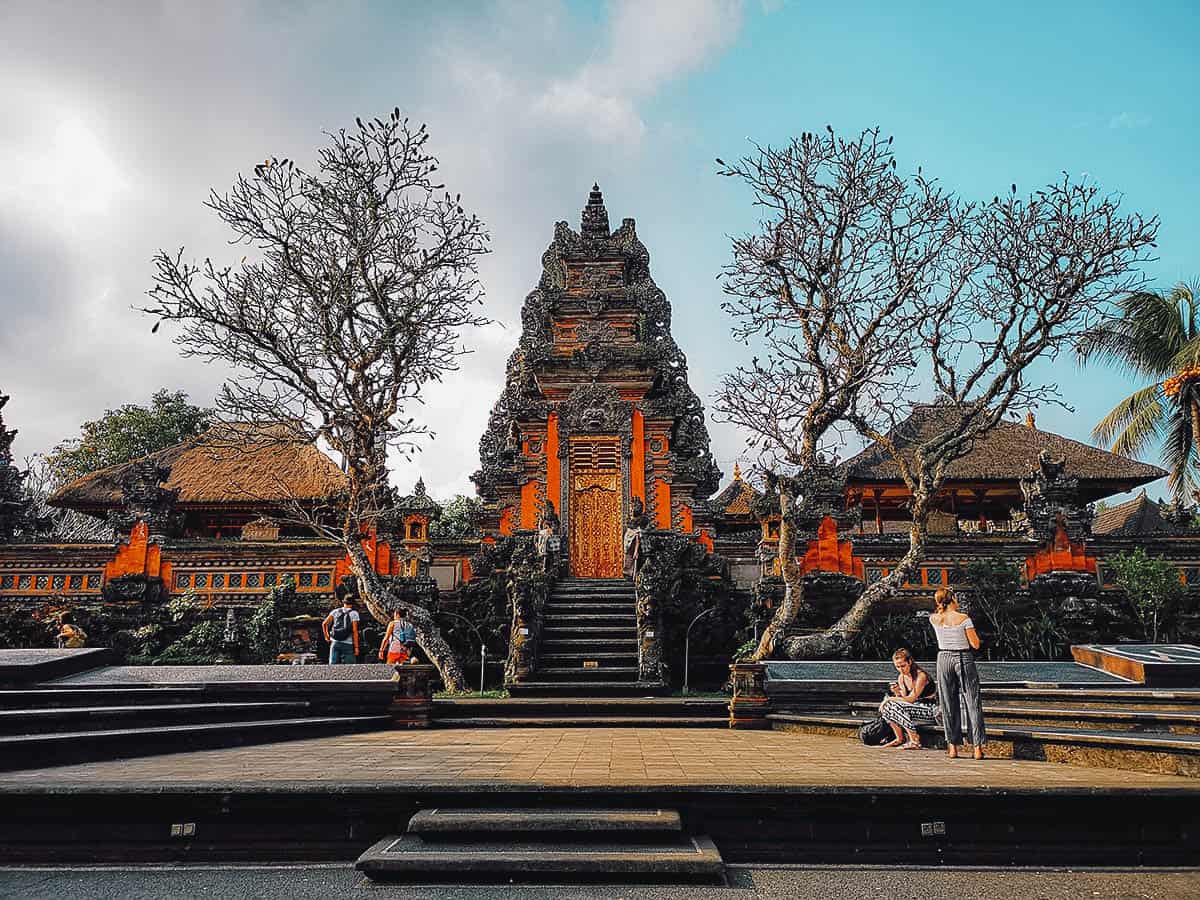
Suggested Length of Visit: Full Day
2. Nusa Penida
We haven’t been here but if you like looking at travel photos on Instagram, then you’re probably already familiar with this place. It’s an island southeast of the mainland that’s become a popular photo backdrop for its coastal cliffs resembling a Tyrannosaurus Rex.
Though the cliffs of Kelingking Beach are the island’s most identifiable feature, there’s lots to appreciate here for nature lovers. Compared to the main island, it’s much less developed and perhaps provides a glimpse of what Bali used to be many years ago.
There are plenty of accommodations on Nusa Penida so many travelers stay for several nights to fully explore the island. However, you can visit on a day trip, either on your own or on a guided tour.
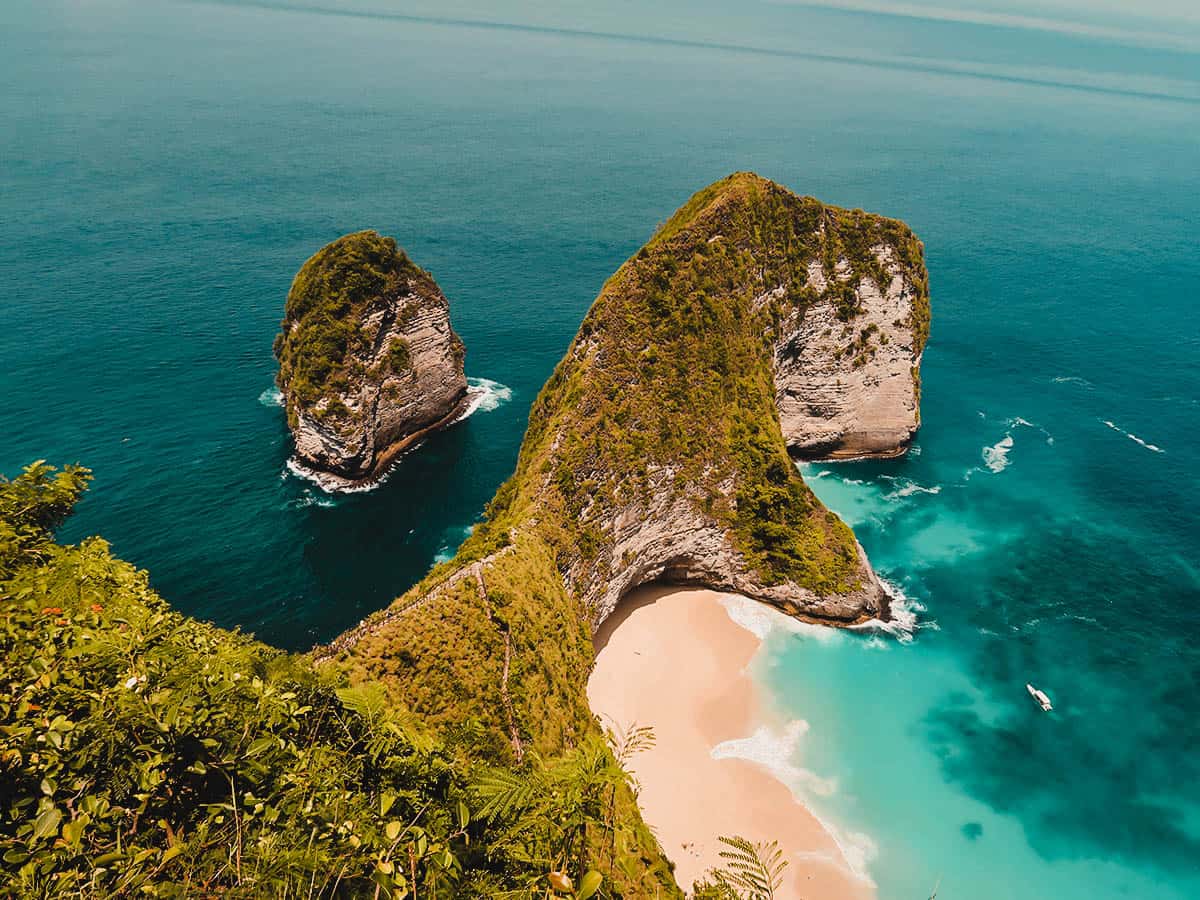
Suggested Length of Visit: Full Day
3. Ayung River
The Ayung River is the longest river in Bali. It starts from the northern mountain ranges and runs for about 68.5 km (42.6 miles) before opening up into the Badung Strait. This River is famous for its white water rafting.
If you’ve had enough rest and relaxation and need a spike of adrenaline in Bali, then you can book a white water rafting adventure on the Ayung River which will be the safest.
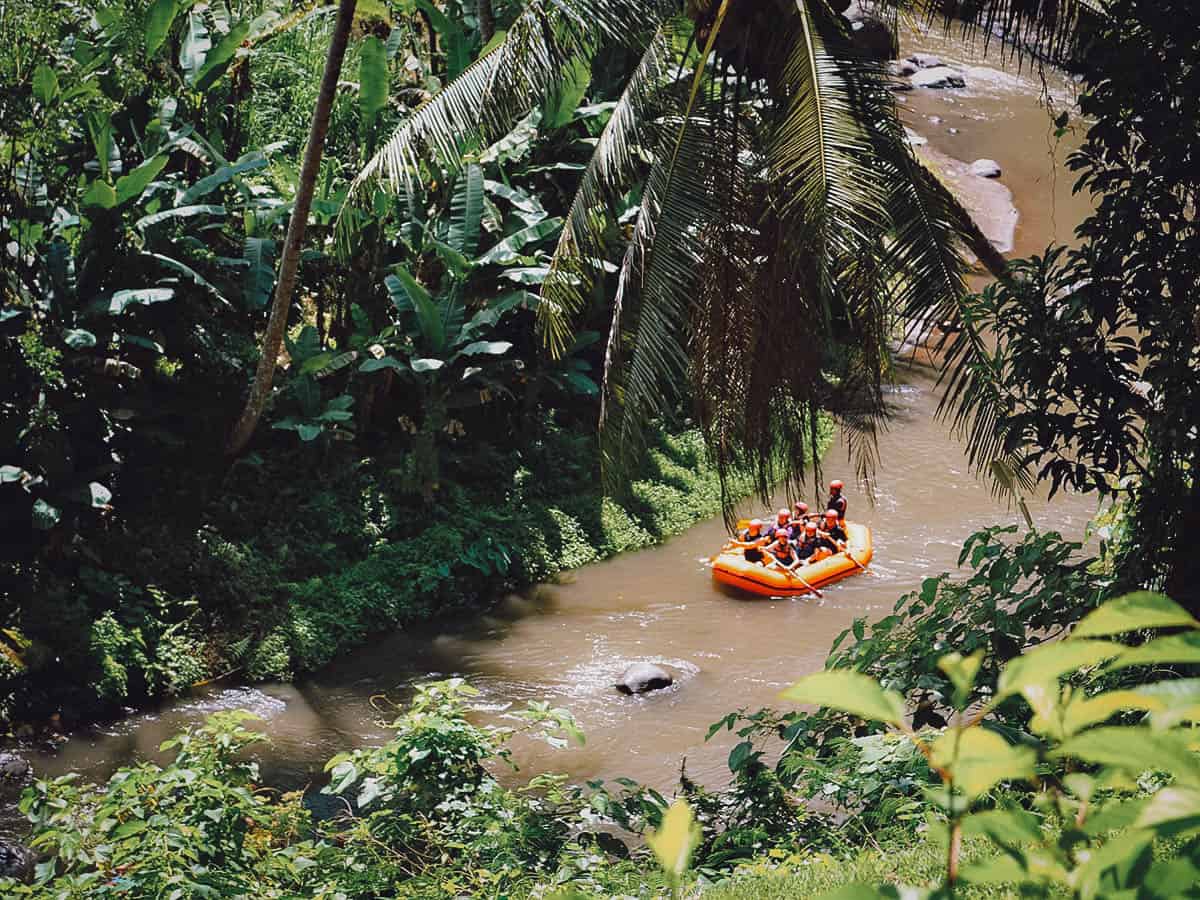
PHOTO: “Ayung River”
4. Tegenungan Waterfalls
There are plenty of picturesque waterfalls in Bali, but Tegenungan Waterfalls is probably one of the most accessible. It’s located between southern Bali and Ubud so you can probably make a stop here en route to central Bali. We visited the waterfalls while on a private car charter, but there are a few guided tours you can join that make a stop there.
By reason of being so accessible, Tegenungan Waterfalls also gets pretty crowded so it may be best to come here first thing in the morning before the crowds get in. If waterfalls and crowds are like oil and water for you, then you can check out this article for a list of Bali’s best Waterfalls.
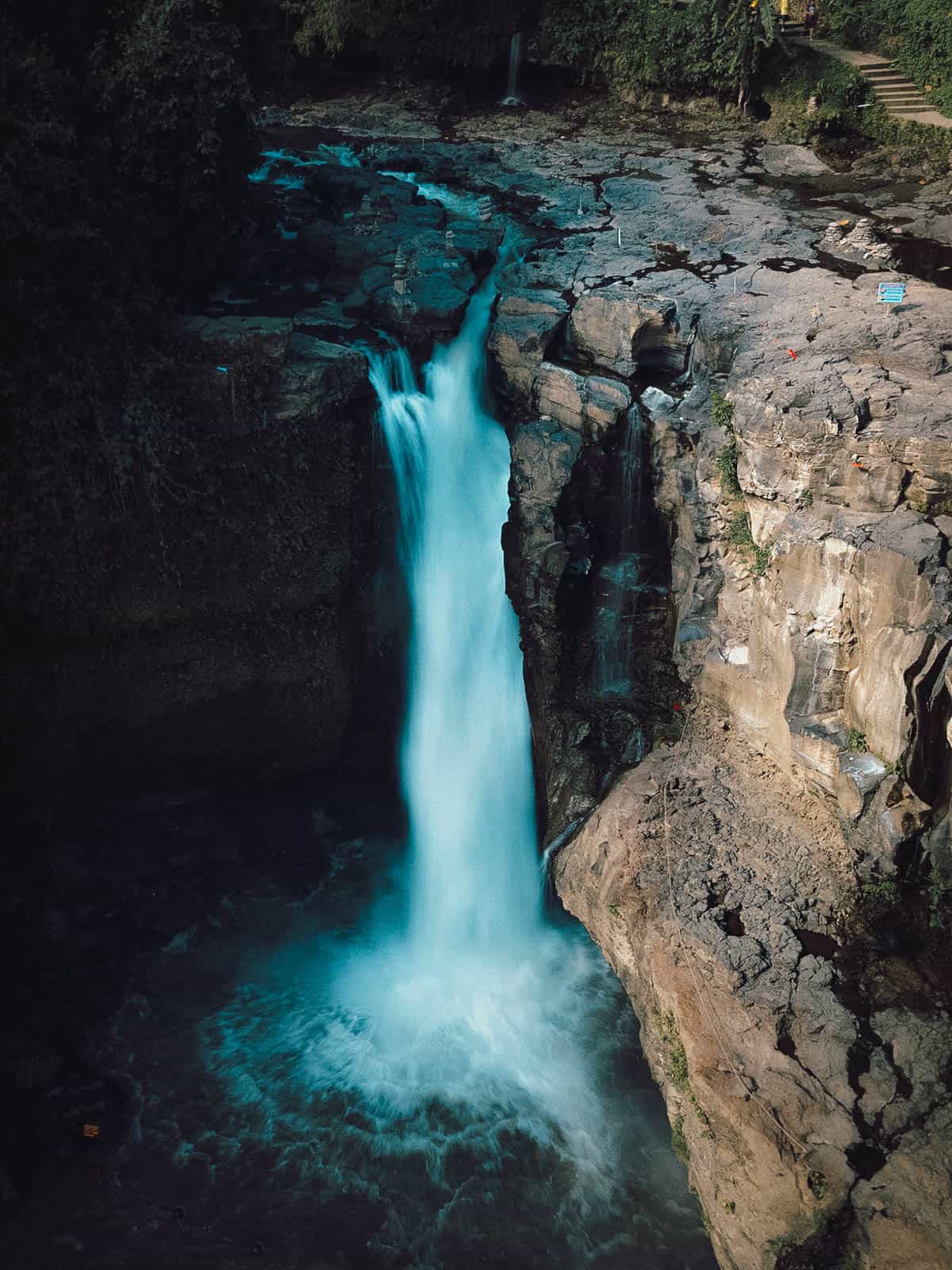
Suggested Length of Visit: Half a Day / Admission: IDR 15,000
HOW TO GET AROUND
Bali is a huge island so getting around to fully appreciate it can be a challenge. It doesn’t have much of a public transportation system other than a network of vans called bemo. Unfortunately it isn’t the most comfortable way of getting around but it’s definitely the cheapest. Check out this article for more on Bali’s bemo minibuses.
A better alternative might be the newer Kura Kura shuttle bus system. It’s a network of air-conditioned minibuses that ply set routes throughout the island. You can get 1-day or 3-day passes that entitle you to unlimited travel for the duration of your pass.
You can also get around by taxi by using Go-Jek, or rental motorbike/scooter. We traveled by Grab Bike a couple of times and it was super fun. It’s faster and cheaper than Grab Car too.
The most convenient way of getting around Bali to go sightseeing is by booking a private car charter with driver. We did this twice in Bali, the first time to explore central Bali and the second to explore the southern past of the island. If you have enough people in your group to split the cost, then this will probably be your best option.
